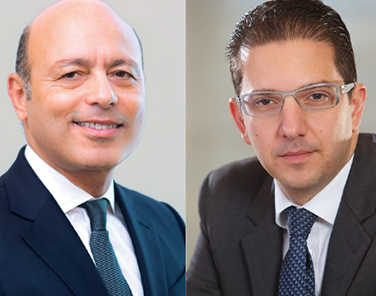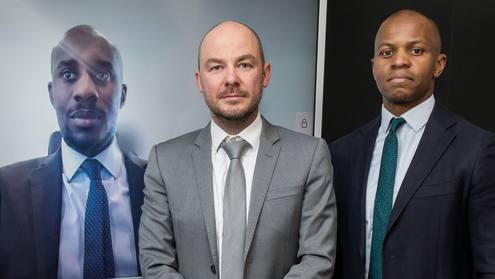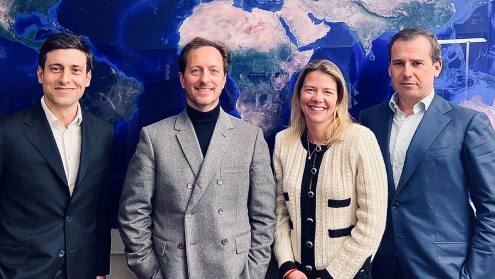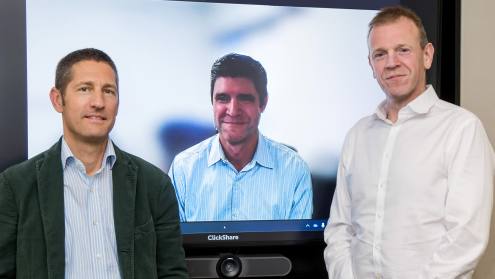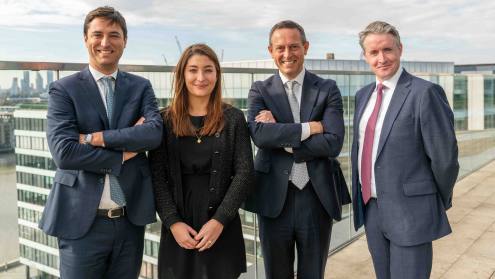Gulf-based corporates have been growing more comfortable with the international capital markets, where they enjoy an increasingly good reputation. Saudi Aramco’s huge debut bond was the most striking recent example of this trend, but there have been others of meaningful size, and Morgan Stanley’s Middle East and north Africa (MENA) investment bankers are certainly having a busy year.
Morgan Stanley has been present in the Middle East since the 1970s, according to Sammy Kayello, the bank’s Dubai-based chairman and CEO for the MENA region. It opened an office in Dubai in 2006, and established a presence in Riyadh and Doha the following year.
“Our mandate extends from Morocco to Kuwait, and has developed well in Gulf Co-operation Council countries,” says Mr Kayello. “We do all the public and private business that we do in London and New York, and in Saudi Arabia we have opened an equity investment management office with an institutional focus.”
The four key investment banking revenue pools, in no particular order, are Egypt, Qatar, Saudi Arabia and the United Arab Emirates. “For the past 13 years, it has always been those four, but they are never all ‘on’ at the same time,” says Patrick Delivanis, head of investment banking MENA at Morgan Stanley. “Today Saudi Arabia is on a growth trajectory.”
Mr Delivanis adds that capital markets growth out of Saudi is being driven by improvements on a number of fronts. “The underlying market infrastructure has improved,” he says. “Processes for raising external capital have improved, as has the equity market infrastructure facilitating foreign involvement.” All of this is supported by the fact that the global investment community’s attitude towards Saudi Arabia has also thawed.
Listing shelved
In 2016, Saudi crown prince Mohammad bin Salman announced that Saudi Aramco, the world’s biggest oil company, would undergo an initial public offering (IPO) by 2018, valuing the company at $2000bn. That would make it the biggest IPO of all time. Global investor response was lukewarm, not least regarding the valuation, and the flotation has reportedly been shelved until at least 2021.
Against that backdrop, coming first to the bond market – a lower-risk proposition – might seem wise. Mr Delivanis believes Aramco was one of the world’s least understood companies, because it was one of the most private. “Introducing the company to the capital markets gradually makes complete sense,” he says. “This provides an opportunity to educate investors and show that the company is dedicated to transparency.”
Preparations for introducing the company to the capital markets in one form or another have clearly been going on for some time, but news of an impending bond issue first circulated towards the end of 2018. Aramco had been pursuing the purchase of a stake in local chemicals giant Sabic and the media linked the two. “It was not the case,” Mr Delivanis maintains.
Morgan Stanley and JPMorgan were mandated as joint global co-ordinators, with the addition of Citi, Goldman Sachs, HSBC and NCB Capital as bookrunners. A five-day, two-team, eight-city international roadshow took place in the first week of April 2019.
The first prospectus published by the company revealed three important marketing themes. One was that Aramco is an autonomous entity. It is chaired by the minister of energy, who is not a member of the royal family. The suggestion is that this makes it less immediately susceptible to royal influence.
Keeping costs down
While Aramco was always a steady earner for its only shareholder, the Saudi government, the relationship between the two was legally formalised in 2017. Since then the tax on most of its income has been reduced from 85% to 50%.
The company also produces at lower cost than any of its peers, thanks to Saudi Arabia’s extraordinary geology as well as its operational and technological excellence. It has opened its books to reveal how very profitable it is, with net income of $111bn in 2018, a 41% return-on-average capital employed and virtually no debt.
The company was rated A1 (stable) by Moody’s and A+ (stable) by Fitch. “But this is an AAA rated company in a lower rated zip code,” says Mr Delivanis.
In the course of the roadshow, investors raised concerns about Aramco's relationship with the Saudi government, but that did not stop them queueing up for the paper. On offer were fixed-term notes with maturities of three, five, 10, 20 and 30 years. A three-year floating rate note was also mooted, though the company eventually decided not to price it.
The demand generated was intense, with orders totalling $100bn, the most ever for a debut issuer. The market had been expecting a $10bn deal, but the issue was finally sized at $12bn.
This was made up of $1bn in three-year notes, with a 2.75% coupon, priced at Treasuries +55 basis points (bps); $2bn five-year (2.875%, plus 75bps); $3bn 10-year (3.5%, plus 105bps); $3bn 20-year (4.25%, plus 140bps); and $3bn 30-year (4.375%, plus 155bps). In every tranche, the pricing tightened by 20bps from initial price thoughts.
The distribution reflected substantial participation from the US and Canada, with a very limited allocation to the Middle East, ending up at 50% North America, 24% Europe, 19% Asia-Pacific and 7% Middle East.
“The message was that this transaction was supported by the global investment grade group,” says Mr Delivanis.
Equity on the side
The prices of all five maturities fell in early trading, reflecting the level of order inflation from investors desperate for an allocation. It is worth noting, however, that when Aramco’s financials were revealed, Saudi sovereign bonds rallied by 20bps. The Aramco bonds priced inside the sovereign curve and that relationship still stands.
Morgan Stanley’s MENA team has also been busy in the equity markets. It was joint global coordinator, alongside Emirates NBD Capital and JPMorgan, in the £1bn ($1.27bn) IPO of Network International, a Middle Eastern and African enabler of digital payments.
Ahead of the London listing, the Dubai-based company appointed Ron Kalifa, former CEO of UK rival Worldpay, as its chairman. The offering comprised 200 million shares from selling shareholders Emirates NBD, General Atlantic and Warburg Pincus. It also featured an overallotment option of another 30 million shares, with a further 50 million sold to Mastercard, which came in as a cornerstone investor.
The shares were ‘heavily oversubscribed’ and priced at 435p, implying a market cap of £2.175bn. They then rose 21% in early trading.
UK investors took 67% of the stock, with 21% going to the US. Only 6% went to the Middle East. “Equity demand for high-quality, homegrown corporates out of the Middle East is very strong,” says Mr Delivanis.
Arabian Centres Company (ACC) is a homegrown, quality corporate. Morgan Stanley was joint financial adviser, with Goldman Sachs, NCB Capital and Samba Capital, in the company’s $748m-equivalent listing on the local Saudi Tadawul exchange.
ACC is the leading owner-developer of shopping malls in Saudi Arabia, where it operates 19 centres across 10 cities. The IPO, which valued the business at $3.3bn, was the country’s first international-style transaction with pre-deal investor education and price stabilisation, and the first Saudi deal to offer shares under the US’s S/144A regulation. It was the largest local IPO since 2014.
“Aramco is an international business, but ACC was a true Saudi consumer story, and there are more to come,” says Mr Delivanis.
Staying the course
The region remains vulnerable to geopolitical upheavals, which affect local economies and markets. The boycott of Qatar by some of its neighbours is only the latest in a string of regional headwinds, which have included war in Syria and the Arab Spring.
“Geopolitics is always a factor,” acknowledges Mr Kayello. “Windows of issuance in the Middle East come and go more quickly than elsewhere. But the demographics of the region are attractive, and it needs plenty of capital market investment.”
It is up to investment banks to ensure that capital markets make a positive contribution, Mr Delivanis suggests. “Investors can be quick to disengage,” he says. “If they get burned once, they will back off for a time. So it is incumbent upon us to do right by the capital markets, to help drive economic activity and benefit the region.”



